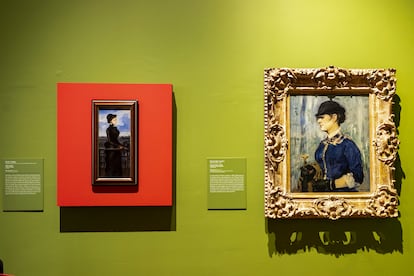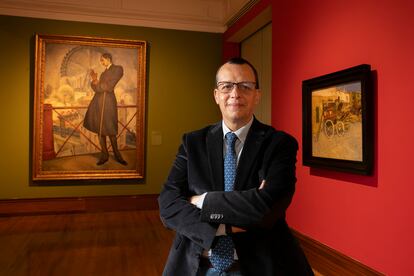The Mexican muralist Diego Rivera traveled to Europe in 1907 with a scholarship from the State of Veracruz. The idea was to study in Spain the works of prominent artists such as Goya or El Greco and soak up the trends that were setting the pace in Madrid, but the restless Rivera left Spain two years later to move to Paris, where he felt that the true moved artistic of the time. It was there where he met Amedeo Modigliani and an intense friendship was forged between both artists.
The French capital was bustling with the avant-garde and Belle Epoquewith enthusiasm for science and progress. “They had a truly powerful friendship,” says Héctor Palhares Meza, director of the National Museum of Modern Art (MUNAL), located in an imposing building in the heart of Mexico City. “They visited each other in Pablo Picasso’s studio, they shared the workshops where they painted, because the profile of the bohemian artist was to pay three or four rents for the studios.” workshops”, says Palhares, who is also the curator of an exhibition that presents for the first time in Mexico and Latin America part of the collection of works by American businessman Henry Pearlman. The sample has been titled Avant-garde dialogues and brings together paintings by Modigliani, Vincent Van Gogh, Alfred Sisley, Camille Pissarro, Paul Cézanne, Henri de Toulouse-Lautrec, Édouard Manet and Pierre-Auguste Renoir. “A banquet,” says the director of the MUNAL, in which these avant-garde artists “dialogue” with their Mexican peers: Rivera, Clausell, Montenegro, Dr. Atl, Orozco, Rodríguez Lozano, Parra and Gedovius.
American magnate Pearlman (1895–1974) made his fortune in the refrigeration and storage container industry through the Eastern Cold Storage Insulation Corporation. He was a passionate collector and for three decades he collected, together with his wife Rose, a large collection of works, mainly by impressionist and post-impressionist artists. Dozens of paintings by creators such as Paul Cézanne, Vincent van Gogh, Modigliani, Paul Gauguin, Édouard Manet, Chaïm Soutine and Henri de Toulouse-Lautrec are part of the collection, which after the death of the businessman and by decision of his wife, was passed on to 1976 on permanent loan to the Princeton University Museum, in New Jersey. Several of the works in the collection have been exhibited in large museums in the United States, Europe and Asia, but they had never been to Latin America and the gateway to the subcontinent has been Mexico.
Palhares Meza explains that the idea of bringing part of the paintings from that collection to Mexico arose four years ago, with the intention of it being a larger exhibition than the current one, but the plans intersected with the covid-19 pandemic. The exhibition has been carefully assembled and designed to generate a dialogue between European and Mexican authors. Next to each painting of the “guests”, as Palhares Meza calls them, a work by an artist from this country is exhibited. This is how Diego Rivera meets again with his great friend, the Italian Modigliani, the artist famous for that beautiful technique of elongating faces and figures. “The intention is to have a double view: the view of Europe from Mexico, but also how Mexico is seen from Europe. Most of these artists met in the Old Continent, they nurtured each other, there were dialogues in sensibilities, in styles, in aesthetic searches,” explains the director of MUNAL.
Rivera and Modigliani forged “a great relationship,” not only as colleagues, but a very personal friendship. “They lived with Jeanne, Modigliani’s wife, and they had a very particular relationship, in that universe of bohemia, of creation, of deconstruction of the world. Rivera spent a very important time in Picasso’s studio home in Montmartre, in Paris, where he came into contact with these great masters. These artistic affinities were not only projected at the beginning of the avant-garde, but also in very close relationships, in that Belle Epoque clothed in an entire bohemian ideal, of consuming opium, wormwood, working until dawn, sleeplessness, caberet, nightclubs, everything that represents the profile of an artist who wanted to live intensely. Modigliani consumed a lot of alcohol, which severely damaged their health,” says Palhares Meza. The death of the Italian painter at just 35 years old due to tuberculosis for Diego Rivera “was a very severe, emotional blow, because Modigliani was a synthesis, for many reasons, of ancient art, of Polynesian art, of African art that people liked so much. Rivera,” says the MUNAL director.
After Modigliani’s death, his pregnant wife Jeanne threw herself from the window of their apartment. “This exhibition allows us to understand all those passionate, emotional cycles,” says Palhares Meza. The room where the exhibition has been set up has been decorated to reflect the Paris of the first decades of the last century, with the industrial boom, electricity, technology, can can music, the construction of magnificent works such as the Eiffel Tower, a world that was opening to modernity. The room opens with a beautiful arch that recalls French Art Nouveau. And it is there where friends meet again. Diego Rivera with a portrait of Adolfo Best Maugard painted in 1913, which he titled Young man on the balconyand which shows a colorful and abstract style, in which the background landscape is the Parisian city, the Montparnasse train station and the smoke from the locomotive merging with that of the factory chimneys. Next to him appears the portrait of the French poet Jean Cocteau, painted in 1916 by Modigliani, dressed in a very elegant navy blue suit, with that style of elongated faces that characterizes the Italian’s work. From the MUNAL they say that when Cocteau saw the work he said: “It doesn’t look like me, but it does look like Modigliani, which is better.”
This idea of “dialogue” between European and Mexican artists, explains Palhares Meza, attempts to reflect the “searches of each artist, the common interests, their proposals.” The official comments, for example, the passion that Dr. Atl (Gerardo Murillo) had with volcanology, a true scientist. His work The cloudfrom 1931, is an example of his artistic period when he sought his source of inspiration in landscapes. At his side is Monte Sainte-Victoirewhich Paul Cézanne painted between 1904 and 1906, “who studies the landscape through reason, a perception of how the horizon has to be curvilinear, like the shape of the eye,” says Palhares Meza. This painting was created by Cézanne accompanied by scientists on an expedition to Provence, in the south of France. “They were found on the slopes of the volcano Sainte-Victoire fossil, paleontological remains, so the work is also a scientific view, which follows Darwin’s precepts of the evolution of species. They were going to paint the origin of modernity, of a century that is interested in technology, in science, in speed,” says the director of MUNAL about the two painters.

One of the most special guests at this avant-garde “banquet” is, of course, Vincent Van Gogh. In the center of the exhibition is exposed Tarascan diligencehis painting from 1888, when the artist had moved to the south of France with the idea of creating a commune of artists, his famous Yellow Housewhere other geniuses such as Paul Gauguin spent time. The Dutchman was already tormented by demons that later led him to be locked up in a psychiatric hospital. He was also tormented by the value or quality of his work and by a life almost always in poverty. “Van Gogh only sold one oil painting in his life, which was the famous Vineyard in red. He sold drawings and sketches, but the only oil painting was that one, because they were artists who broke with what the value of impressionism implied,” says Palhares Meza. In a letter that the painter sent to his brother Theo, in which he included a drawing of the painting shown in the MUNAL, the artist wrote: “Forgive this very bad sketch, I am almost dead from painting that Tarascón stagecoach so much and I see that I have no brain to draw.” The work takes the novel as a reference Tartarin of Tarasconby Alphonse Daudet, which the painter was passionate about. “It is a very endearing work,” explains Palhares Meza. It is an example of Van Gogh’s “impulses,” of that “schizophrenic psychosis that was also linked to all his creative work, the use of color, his way of living and feeling,” he adds.
The exhibition is an international project that allows art lovers to encounter for the first time pieces by the great masters of painting, by Mexican and European artists. The exhibition opened on September 12 and will be available until January. MUNAL reports that 17,469 people have already visited it, a complete success. “It is a truly careful selection. Each of these painters are diners invited to a first-rate banquet,” defines the director of MUNAL. Landscapes, portraits, nudes, still lifes, avant-garde, geometric lines, burst of colors. Art marked by the illusions and passions of artists, madness and happiness, the search for beauty and, of course, friendship, like that of Diego Rivera and Amedeo Modigliani, who meet again in these walls of one of the most beautiful museums in Mexico City.
Sign up for the EL PAÍS México newsletter for free and to whatsapp channel and receive all the key information on current events in this country.

